The Floral Extract market is experiencing notable growth owing to the increasing utilization of plant-based and naturally derived ingredients across cosmetics, personal care, and food industries. The growing awareness regarding the therapeutic and aromatic benefits of floral extracts has been driving their adoption in formulations that emphasize clean labeling and sustainability.
Rising consumer inclination toward organic and cruelty-free products is further propelling the demand for high-quality floral extracts, particularly in skincare and aromatherapy applications. Continuous advancements in extraction technologies such as steam distillation and cold pressing have improved yield efficiency and product purity, enhancing the market potential.
Additionally, increasing investments by manufacturers in developing innovative extraction methods and expanding production capacities are supporting market expansion As the global wellness trend continues to gain momentum and consumers seek nature-inspired products, floral extracts are expected to witness sustained demand in the coming years, with significant growth opportunities in both developed and emerging economies.
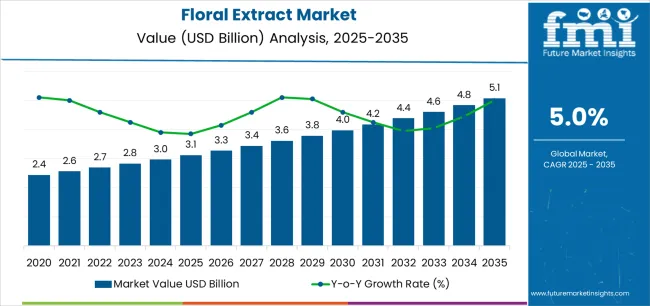
| Metric | Value |
|---|---|
| Floral Extract Market Estimated Value in (2025E) | USD 3.1 billion |
| Floral Extract Market Forecast Value in (2035F) | USD 5.1 billion |
| Forecast CAGR (2025 to 2035) | 5.0% |
The market is segmented by Extract Type, Nature, Source, Method, and Application and region. By Extract Type, the market is divided into Essential Oil, Concretes, and Absolutes. In terms of Nature, the market is classified into Natural and Organic. Based on Source, the market is segmented into Rose, Jasmine, Lavender, Tuberose, Mimosa, Marigold, Lotus, Ylang Ylang, Frangipani, Champaca, and Others. By Method, the market is divided into Solvent Extraction, Distillation, Expression, and Supercritical Fluid Extraction. By Application, the market is segmented into Skincare, Haircare, Makeup, Body Care & Toiletries, and Fragrances. Regionally, the market is classified into North America, Latin America, Western Europe, Eastern Europe, Balkan & Baltic Countries, Russia & Belarus, Central Asia, East Asia, South Asia & Pacific, and the Middle East & Africa.
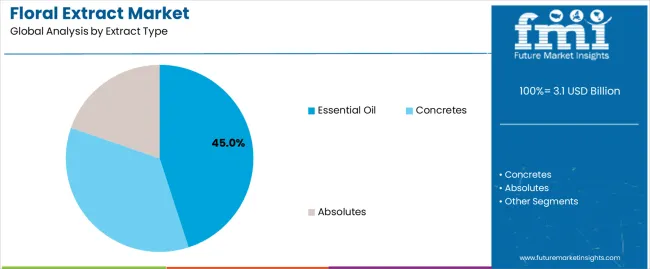
The essential oil segment is anticipated to hold 45.00% of the floral extract market share in 2025, making it the leading extract type. The segment has been supported by the growing demand for high-concentration, aromatic compounds that provide functional benefits in cosmetics, personal care, and home fragrance applications. Essential oils have gained prominence due to their versatility, purity, and compatibility with various formulations.
Advancements in extraction and purification technologies have enhanced the consistency and quality of essential oils, increasing their acceptance across end-use sectors. The shift toward natural and chemical-free ingredients has further strengthened their position in the market.
Additionally, the segment has benefited from rising consumer interest in aromatherapy and wellness-focused products, which rely heavily on essential oils for therapeutic benefits As manufacturers continue to innovate with sustainable sourcing and efficient extraction methods, the essential oil segment is expected to maintain its dominance in the floral extract market.
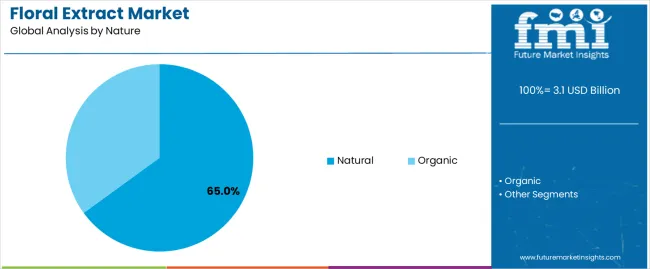
The natural segment is expected to account for 65.00% of the floral extract market revenue share in 2025, positioning it as the leading nature category. This growth has been driven by the strong consumer shift toward clean beauty, organic personal care, and environmentally friendly products. The preference for naturally sourced ingredients has been reinforced by growing awareness of the potential health risks associated with synthetic additives.
Manufacturers have increasingly adopted natural extraction processes to align with consumer expectations for transparency and purity. The expansion of wellness and plant-based product portfolios across industries has further strengthened this segment’s growth.
Additionally, regulatory support for sustainable sourcing and reduced chemical usage in formulations has encouraged the use of natural floral extracts As brands focus on offering traceable and ethically produced ingredients, the natural segment continues to experience strong demand and is expected to remain the key driver of market growth.
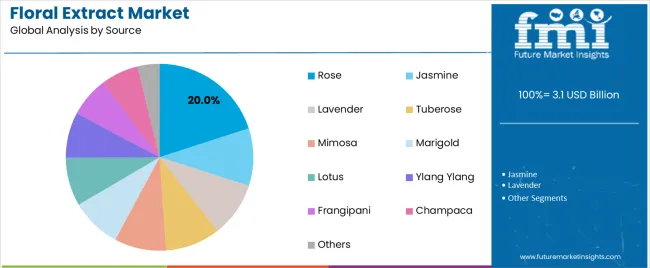
The rose source segment is projected to hold 20.00% of the floral extract market share in 2025, establishing it as a key source type. The segment has been driven by the widespread use of rose-based extracts in premium skincare, perfumery, and wellness products owing to their high antioxidant and soothing properties. The distinctive aroma and therapeutic benefits of rose extracts have made them a preferred choice in formulations aimed at relaxation, hydration, and rejuvenation.
Advances in cultivation and extraction processes have enabled the production of high-purity rose extracts, ensuring consistency in fragrance and efficacy. The rising popularity of botanical actives in personal care and cosmetic formulations has reinforced the growth of this segment.
Moreover, the increasing use of rose extracts in aromatherapy and luxury fragrance products has further contributed to its strong market position With growing consumer preference for natural and sensorially appealing ingredients, the rose segment is expected to sustain steady growth in the floral extract market.
According to the analysis, the market of floral extract has seen a moderate growth rate from the year 2020 to 2025, primarily due to the rising usage of natural products in the production of personal care and cosmetic products. The historic market grew at a CAGR of about 4.2%, reaching USD 2,818.9 million by 2025 end.
Further, it is predicted that the market is set to grow, with a higher CAGR of 5.0% during the forecast period. Forecasting the given market, by 2035, it is expected to amount to USD 4,832.8 million. This is on the back of higher demand in the pharmaceutical industries, food and beverages industries as well as growth in the clean beauty segment.
Moreover, an increase in the middle-aged group of people in several developing countries and a rising interest in environmental sustainability will support the demand for floral extracts. North America and Europe will remain important markets, however, Asia-Pacific is forecast to have the highest growth rate due to strong and unceasing urbanization and improving disposable income.
The growing popularity of natural products, as well as their increased use in various types of cosmetic formulations such as hair care, facial treatment, and perfumes, resulted in the growth of the market for floral extract products.
Furthermore, factors such as changing lifestyles, consumption patterns, and rising demand for organic cosmetics are a driving force. People have become increasingly environmentally conscious and it has LED to an increase in the number of manufacturers using plant extracts, including flower extract ingredients. These extracts are used in cosmetic formulations such as facial creams and body lotions, which will alternatively propel the market in the coming years.
An Emergence of Socially- Conscious Consumer to Boost Market Growth
A new global trend has emerged recently, the emergence of socially conscious consumers. Consumers' purchasing criteria have shifted as the demand for natural or organic products is on a progressive trend. This might be due to the increased awareness, putting pressure on manufacturers to produce natural ingredient mixed or organic products in line with the agenda towards sustainability.
Rising health & environmental concerns also generate demands for cosmetic products which are eco-friendly. The global socially conscious consumers want to purchase products which are good for them as well as for the planet. In this way, floral extract products which are completely natural and/or organic, are healthy and do not harm society. Thus, a growing demand for natural products from the floral extract market, especially essential oils has been observed in the floral extract market.
Growing Vegan Population and Rising Focus on Organic/Natural Ingredients to Boost Floral Extract Sales
The USA is considered a lucrative market for floral extract and is expected to register a significant CAGR of 3.2%. The increased demand for floral extracts in the USA is highly influenced by the growing vegan population and rising focus of organic and natural ingredients products which transformed almost every aspect of the beauty industry.
Further, with a strong desire for cosmetics to be cruelty-free, many brands are focusing on bringing vegan perfumes and personal care products devoid of animal-based ingredients into the markets, thereby potentially raising the demand for plant-based products such as floral extract.
Expansion of Beauty & Fragrance Industry to Experience Augmented Demand for Floral Extracts
The Indian market is expected to rise at an impressive growth rate. The market is driven by the ever-expanding beauty and fragrance industry in the Indian market, on account of unprecedented urbanization, increased incomes, a rise in the number of working women, and the growing importance of men's grooming products, which will signify ample growth opportunities for the stakeholders.
Key Brands Shifting Focus Toward Natural/Organic Ingredients to Boost Product Sales
Europe is expected to remain one of the key markets. Accounting for a majority of the market share. Germany held the largest market share in 2025 in Europe. Germany offers greater opportunities for floral extract manufacturers, due to the emergence of a large number of beauty brands focusing entirely on natural and organic ingredients.
Further, as the cosmetics and personal care industry is taking to a whole new level through ‘personalized’ products, floral extract manufacturers are likely to witness a period of sustained demand.
Health and Wellness Conscious Consumer to Opt for Essential Oils
In terms of extract type, the essential oil category dominated the market with the highest revenue share of 48.7% in 2025. Essential oils have been increasingly gaining prominence in both developed and developing countries, and the result is likely to lead to increased demand for floral extracts.
In an attempt to maintain a healthy lifestyle, today’s consumers are turning to products and practices that not only enhance their physical appearance but also help improve health and wellness. On the back of these factors, the essential oil category is anticipated to dominate the target market throughout the forecast period.
Beneficial Natural Floral Extract Gaining Prominence in the Current Market Scenario
Based on the nature segment, the natural category dominated the global market with the highest revenue share of 61.1% in 2025. The natural ingredient market is growing due to its beneficial properties such as anti-wrinkle agents, lightening/whitening agents, healing agents etc.
Healthy living is considered the current trend in the natural cosmetics market that drives the demand for ingredients coming from the floral extract market, which is further propelling the category forward in the global market.
Anti-Inflammatory & Anti-Oxidant Properties of Rose Highly Preferred by Consumers
In the global floral extract market, the demand for roses is increasing in the skincare industry due to its benefits in its anti-inflammatory and antioxidant properties. Rose is high in vitamins and minerals, and its oil is excellent for treating dry skin. It also has astringent properties, making it a powerful anti-acne, anti-redness, and anti-inflammatory agent.
These are a few of the factors that have facilitated growth in the adoption of rose-based floral extract in the market.
High Efficiency & Compatibility of Distillation Method Providing Towards Market Growth
Based on the method segment, the distillation method category accounted for a significant share of 44.1% of the global market in 2025. The distillation method is the most used technique for the floral extract market across the world.
Steam distillation is widely used for essential oil extraction and is very popular in the floral extract market. However, some flowers are too delicate for the distillation process. In that case, another popular method which is known as solvent extraction is used in the floral extract industry.
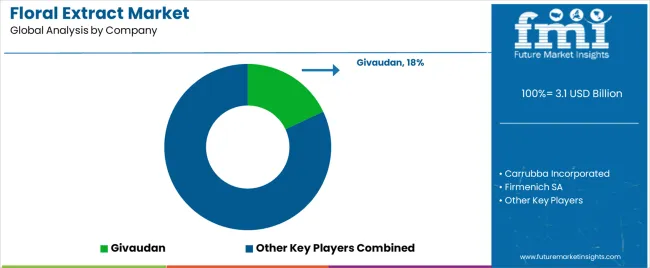
Leading players operating in the global market are focusing on expansion, development, and new product launches to expand their business globally.
For Instance
| Attribute | Details |
|---|---|
| Forecast Period | 2025 to 2035 |
| Historical Data Available for | 2020 to 2025 |
| Market Analysis | USD Million for Value |
| Key Regions Covered | North America, Latin America, Europe, East Asia, South Asia, Oceania & MEA |
| Key Countries Covered | United States, Canada, Brazil, Mexico, Germany, UK, France, Spain, Italy, Russia, Benelux, South Africa, Northern Africa GCC Countries, China, Japan, South Korea, India, Thailand, Malaysia, Indonesia, Australia & New Zealand |
| Key Segments Covered | Extract Type, Nature, Source, Method, Application, Region |
| Key Companies Profiled | Carrubba Incorporated; Firmenich SA; Givaudan; Hddes Group; Herbarom; International Flavors & Fragrances Inc.; Kalishankar Export; Kancor Ingredients Limited; Katyani Exports; Lebermuth; Mane SA; Nateva Sas; Nesso-Natural & Essential Oils Pvt. Ltd.; Plantex; Robertet; Star Kay White, Inc.; Symrise; Synthite Industries Pvt. Ltd.; Takasago; Uchiya Essential Oils |
| Report Coverage | Market Forecast, Company Share Analysis, Competition Intelligence, DROT Analysis, Market Dynamics and Challenges, and Strategic Growth Initiatives |
| Customization & Pricing | Available upon Request |
The global floral extract market is estimated to be valued at USD 3.1 billion in 2025.
The market size for the floral extract market is projected to reach USD 5.1 billion by 2035.
The floral extract market is expected to grow at a 5.0% CAGR between 2025 and 2035.
The key product types in floral extract market are essential oil, concretes and absolutes.
In terms of nature, natural segment to command 65.0% share in the floral extract market in 2025.






Our Research Products

The "Full Research Suite" delivers actionable market intel, deep dives on markets or technologies, so clients act faster, cut risk, and unlock growth.

The Leaderboard benchmarks and ranks top vendors, classifying them as Established Leaders, Leading Challengers, or Disruptors & Challengers.

Locates where complements amplify value and substitutes erode it, forecasting net impact by horizon

We deliver granular, decision-grade intel: market sizing, 5-year forecasts, pricing, adoption, usage, revenue, and operational KPIs—plus competitor tracking, regulation, and value chains—across 60 countries broadly.

Spot the shifts before they hit your P&L. We track inflection points, adoption curves, pricing moves, and ecosystem plays to show where demand is heading, why it is changing, and what to do next across high-growth markets and disruptive tech

Real-time reads of user behavior. We track shifting priorities, perceptions of today’s and next-gen services, and provider experience, then pace how fast tech moves from trial to adoption, blending buyer, consumer, and channel inputs with social signals (#WhySwitch, #UX).

Partner with our analyst team to build a custom report designed around your business priorities. From analysing market trends to assessing competitors or crafting bespoke datasets, we tailor insights to your needs.
Supplier Intelligence
Discovery & Profiling
Capacity & Footprint
Performance & Risk
Compliance & Governance
Commercial Readiness
Who Supplies Whom
Scorecards & Shortlists
Playbooks & Docs
Category Intelligence
Definition & Scope
Demand & Use Cases
Cost Drivers
Market Structure
Supply Chain Map
Trade & Policy
Operating Norms
Deliverables
Buyer Intelligence
Account Basics
Spend & Scope
Procurement Model
Vendor Requirements
Terms & Policies
Entry Strategy
Pain Points & Triggers
Outputs
Pricing Analysis
Benchmarks
Trends
Should-Cost
Indexation
Landed Cost
Commercial Terms
Deliverables
Brand Analysis
Positioning & Value Prop
Share & Presence
Customer Evidence
Go-to-Market
Digital & Reputation
Compliance & Trust
KPIs & Gaps
Outputs
Full Research Suite comprises of:
Market outlook & trends analysis
Interviews & case studies
Strategic recommendations
Vendor profiles & capabilities analysis
5-year forecasts
8 regions and 60+ country-level data splits
Market segment data splits
12 months of continuous data updates
DELIVERED AS:
PDF EXCEL ONLINE
Extraction Kits Market Analysis - Size, Share, and Forecast Outlook 2025 to 2035
Floral Nectar Market - Trends, Growth & Forecast 2025 to 2035
Floral Flavor Market Analysis by Raw Material and Product Type Through 2035
Extracts and Distillates Market
Sage Extract Market Size and Share Forecast Outlook 2025 to 2035
Fume Extractor Market Size and Share Forecast Outlook 2025 to 2035
Meat Extracts Market Size and Share Forecast Outlook 2025 to 2035
Kale Extract Skincare Market Size and Share Forecast Outlook 2025 to 2035
Wine Extract Market Size and Share Forecast Outlook 2025 to 2035
Amla Extract Market Analysis - Size, Share, and Forecast Outlook 2025 to 2035
Dust Extractor Market Growth – Trends & Forecast 2025 to 2035
Data Extraction Software Market
Lipid Extraction Kit Market Size and Share Forecast Outlook 2025 to 2035
Peony Extract Brightening Creams Market Analysis - Size, Share, and Forecast Outlook 2025 to 2035
Peony Extracts for Brightening Market Size and Share Forecast Outlook 2025 to 2035
Algae Extracts Market Size and Share Forecast Outlook 2025 to 2035
Juice Extraction Equipment Market Size and Share Forecast Outlook 2025 to 2035
Yucca Extract Market Size and Share Forecast Outlook 2025 to 2035
Maple Extracts Market Size and Share Forecast Outlook 2025 to 2035
Yeast Extract Market Analysis - Size, Share, and Forecast Outlook 2025 to 2035

Thank you!
You will receive an email from our Business Development Manager. Please be sure to check your SPAM/JUNK folder too.
Chat With
MaRIA